How do Organisms Reproduce - Revision Notes
CBSE Class 10 Science
Revision Notes
CHAPTER – 8
HOW DO ORGANISM REPRODUCE
- Reproduction is the process by which living organisms produce new individuals similar to themselves. It basically involves the making copies of the blueprints of the body design.
- Reproduction ensures continuity of life on earth.
- Chromosomes in the cell contain the information for inheritance of features which are passed from generation to generation in form of DNA molecules.
- so reproduction involves copying of DNA and other cell apparatuses. The copies will be similar to original and not identical.
- This property is Variation which is the basis and necessary for evolution of living beings.
- Variations help the species to withstand drastic environmental changes, thus save the species from becoming extinct and promotes its survival for a longer time.
REPRODUCTION | |
Asexual Reproduction | Sexual Reproduction |
- Asexual Reproduction is extremely useful as a mean of rapid multiplication. It is common in lower plants and animals.
MODES OF ASEXUAL REPRODUCTION : the mode depends on the body design of the organism.
1. FISSION:The parent cell divides/splits into two daughter cell-Binary Fission; splits into many cells-multiple Fission.
FISSION | |
Binary Fission Equal halves (daughter cells) ->Leishmania has a whip-like structure at one end and binary fission occurs in a definite orientation. | Multiple Fission The parent cell divides into many daughter cell simultaneously. Eg. Plasmodium |
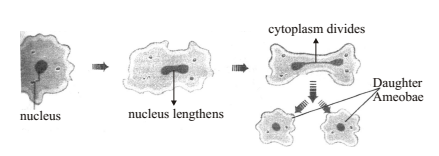
the process where nucleus lengthens is NUCLEOKINESIS and where the cytoplasm lenghthens is CYTOKINESIS.
2. BUDDING: A bud develops as an outgrowth on parent body due to repeated cell division at a specific site. These buds detach from the parent body when they mature.
E.g. Hydra, yeast.
3. SPORE FORMATION : Spores which are present in sporangia, are small, bulb like structure which are covered by thick walls that protect them until they come in contact with suitable condition. Under favourable conditions, they germinate and produce new Rhizopus indiviual.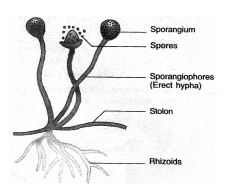
4. FRAGMENTATION : It takes place in multicellular organism with simple body organisation.
It is the accidental process when the brokenpieces of an organism (fragments) grows into a complete organism.
5. REGENERATION : When the simple animals like Hydra ,Planaria develop a new individual from their broken older part it is known as regeneration. It is carried out by specialised cells which divide and differentiate to form the complete individual. These cells multiply and from this mass of cells other parts are generated. Regeneration follows an organised sequence referred to as DEVELOPMENT.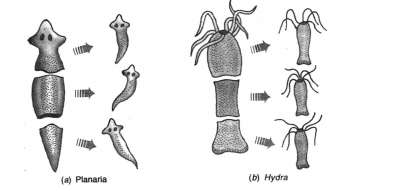
Vegetative Propagation
A mode of reproduction in which reproduction takes place from the vegetative parts like the stem, root, leaves.
Methods of Vegetative Propagation
Natural
1. By Roots : E.g. adventitious roots of Dahlias
2. By Stems : E.g. Potato (tuber), ginger (rhizome)
3. By Leaves :E.g. leaves of bryophyllum bear adventitious buds (in the notches of leaf margin) which develop into new plants.
Artificial
1. Grafting : E.g. Mango.
2. Cutting : E.g. Rose
3. Layering : E.g. Jasmine
4. Tissue adture : E.g. Orchids, Ornamental Plants.
Benefits of Vegetative Propagation
1. Plants can bear flowers, fruits earlier than those produced from seeds.
2. Growing plants like Banana, orange, rose, jasmine that have lost the capacity to produce seeds.
3. Genetical similarity is maintained in the plants.
4. Helps in growing seedless fruits.
5. Cheaper and easier method of growing plants.
Sexual Reproduction
When reproduction takes place as a result of fusion of two gamets, one from each parent, it is called sexual reproduction.
- The process of fusion of male and female gametes is called fertilization.
- The formation of gamets involves exchange of chromosomal (genetic)fragments between homologous chromosomes causing genetic recombination which leads to variation.
Sexual Reproduction in Plants
It occurs mostly in flowering plants. In fact flowers are the reproductive organ of plants.
FLOWERS | |
Bisexual Flowers Both male and female reproductive part i.e., stamen & carpel are present & carpel are present. Eg. Hibiscus, mustard | Multiple Fission The parent cell divides into many daughter cell simultaneously. Eg. Plasmodium |
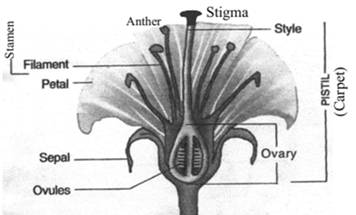
A typical flower consists of four main whorls namely calyx (sepals), Corolla (Petals), Androecium (Stamens) and Gynoecium (Carpels).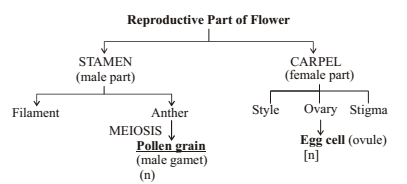
- Pollen grains of a flower , transfer to the stigma of the carpel of the same flower (Self-Pollination)or to the stigma of carpel of the another flower (Cross-Pollination).
- This transfer of pollens is achieved by agent like wind, water or animals.
- After Pollination, a pollen tube grows out of pollen grains, through which male germ cell reaches the ovary and fuses with the female germ cell.
- Fertilization : The fusion of male and female gamete is called fertilization. It occurs inside the ovary. Zygote is produced in this process.
- OVARY->OVULE->EGG CELL AND POLAR NUCLEI.
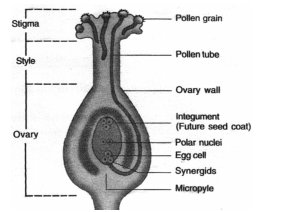
- Zygote divides several times to form an embryo within the ovule. The ovule develops a tough coat and is converted into a seed.
- Ovary grows rapidly and ripens to forms a fruit, while the seed contains the future plant or embryo which develops into a seedling under suitable condition. This process is known as Germination.
- Flowers can also be unisexual(contain either stamen or carpel) or bisexual(contains both stamen and carpel).
- Unisexual flowers :PAPAYA ,WATERMELON .Bisexual flowers:HIBISCUS,MUSTARD.
Reproduction in Human Beings
- Humans use a Sexual Mode of reproduction.
- It needs sexual maturation which includes creation of the germ cells ie, egg (ova) in the female and sperm in the male partener & this period of sexual maturation is called Puberty.
Male Reproductive System
- The formation of male germ cell (sperms) takes place in the testes(male reproductive organ)
- A pair of testes are located inside scrotum which is present outside the abdominal cavity. Scrotum has a relatively low temperature needed for the production of sperms by testes.
- Testes release a male sex hormone called testosterone and its function is to:
1. Regulate the production of sperm
2. Bring about changes in appearance seen in boys at the time of puberty.
- The sperms along with the secretion of prostate gland and seminalvesicle, together constitute semen, which is released and made to enter into the female genital tract during Copulation.
Female Reproductive System
- The female germ cells or eggs are produced in the ovaries. (located in both side of abdomen).
- When a girl is born, the ovaries already contain thousands of immature eggs.
- At puberty, some of these eggs start maturing. One egg is produced every month by one of the ovaries.
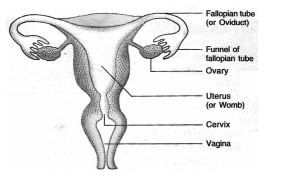
- The Egg is carried from the ovary to the womb through a fallopian tube. These two fallopian tube unite into an elastic bag like structure known as uterus.
- The Uterus opens into the vagina through the cervix.
- Fertilization occurs in the fallopian tube of female genital tract.
- The fertilized egg also called zygote (2n) gets implanted in the lining of the uterus, and start dividing. Actually uterus is richly supplied with blood to nourish the growing embryo. If zygote is not formed, the inner wall of uterus breaks which causes bleeding through vagina. This process is called MENSTRUATION. It occurs at a regular interval of 28 days.
- The Embryo gets nutrition from the mother's blood with the help of a special tissue called PLACENTA. It provides a large surface area for glucose and oxygen to pass from the mother to the embryo. Similarly the wastes from developing embryo are removed to mother's blood through placenta.
- The time period from fertilization upto the birth of the baby is called Gestation Period. In humans, it is about nine months (36 weeks).
- The sexual cycle (Menstruation) in a woman continues upto the age of 45-50 years. After that the ovaries do not release egg. This stage is called Menopause. It also marks the end of the reproductive life of a woman.
- Female sex hormones are oestrogen and progesterone which are produced by ovary.
Reprocutive Health:
- Reproductive Health means a total well-being in all aspects of reproductive, i.e., physical emotional, social and behavioural.
- Contraception : It is the avoidance of pregnancy. It can be achieved
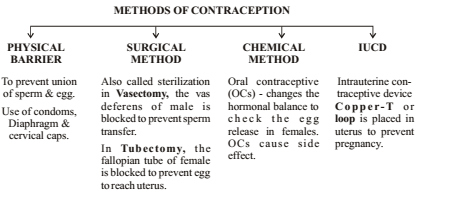
- Healthy society needs a balanced sex ratio that can be achieved by educating people to avoid malpractices like female foeticide & prenatal sex determination.

What you have learnt
- Reproduction, unlike other life processes, is not essential to maintain the life of an individual organism.
- Reproduction involves creation of a DNA copy and additional cellular apparatus by the cell involved in the process.
- Various organisms use different modes of reproduction depending on their body design.
- In fission, many bacteria and protozoa simply divide into two or more daughter cells.
- Organisms such as hydra can regenerate if they are broken into pieces. They can also give out buds which mature into new individuals.
- Roots, stems and leaves of some plants develop into new plants through vegetative propagation.
- These are examples of asexual reproduction where new generations are created from a single individual.
- Sexual reproduction involves two individuals for the creation of a new individual.
- DNA copying mechanisms creates variations which are useful for ensuring the survival of the species. Modes of sexual reproduction allow for greater variation to be generated.
- Reproduction in flowering plants involves transfer of pollen grains from the anther to the stigma which is referred to as pollination. This is followed by fertilisation.
- Changes in the body at puberty, such as increase in breast size in girls and new facial hair growth in boys, are signs of sexual maturation.
- The male reproductive system in human beings consists of testes which produce sperms, vas deferens, seminal vesicles, prostate gland, urethra and penis.
- The female reproductive system in human beings consists of ovaries, fallopian tubes, uterus and vagina.
- Sexual reproduction in human beings involves the introduction of sperm in the vagina of the female. Fertilisation occurs in the fallopian tube.
- Contraception to avoid pregnancy can be achieved by the use of condoms, oral pills, copper-T and other methods.
